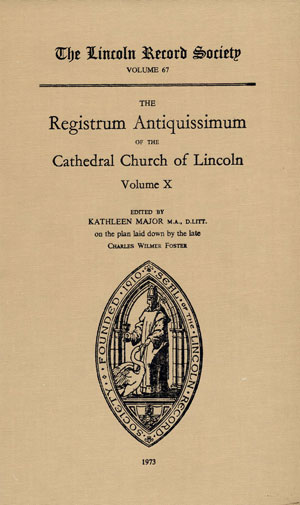
** A reprint of this volume will soon be available **
The Registrum Antiquissimum is the earliest complete cartulary of Lincoln Cathedral. It was written mainly in the third decade of the thirteenth century. It was prepared from the original texts, many of which have not survived. Canon Foster noted that its writer ‘copied with literal accuracy. As a consequence his texts may be relied upon’.
The period originally proposed to be covered extended from the year 1061, the date of the only pre-Conquest document to the death of Bishop Hugh of Wells in 1235. However it was found convenient, and indeed necessary, to print many documents which are later in date.
The charters illustrate the history of an English secular cathedral church in respect of its organisation and personnel, its endowments and its franchises. The Introduction notes that the texts of 7,826 charters have survived of which 4,200 are the original documents. There are 1,073 charters in the Registrum Antiquissimum. Volume I contains the texts of 308 documents.
The documents in the Registrum Antiquissimum include charters of the possessions not only of the common of the canons, and of the prebends, but also of the see of Lincoln. These possessions lay dispersed throughout the diocese of Lincoln which, as constituted by William the Conqueror, stretched, until the middle of the sixteenth century, from the Humber to the Thames. It comprised the counties of Lincolnshire, Leicestershire, Northamptonshire, Rutland, Huntingdon, part of Hertfordshire, Bedfordshire, Buckinghamshire, and Oxfordshire. Outside the diocese, the charters relate to land in London and in the counties of Berkshire, Derbyshire, Hampshire, Kent, Nottinghamshire, Surry, and Yorkshire. But it is for the history of the Northern Danelaw that the Lincoln charters are of first-rate importance.
Adapted from the Introduction
This is the third volume of charters relating to properties in the city of Lincoln. The preface describes the history of the series together with details of the contents of Volume X.
The Registrum Antiquissimum is the earliest complete cartulary of Lincoln Cathedral. It was written mainly in the third decade of the thirteenth century. It was prepared from the original texts, many of which have not survived. Canon Foster noted that its writer ‘copied with literal accuracy. As a consequence his texts may be relied upon’.
The period originally proposed to be covered extended from the year 1061, the date of the only pre-Conquest document to the death of Bishop Hugh of Wells in 1235. However it was found convenient, and indeed necessary, to print many documents which are later in date.
The charters illustrate the history of an English secular cathedral church in respect of its organisation and personnel, its endowments and its franchises. The Introduction notes that the texts of 7,826 charters have survived of which 4,200 are the original documents. There are 1,073 charters in the Registrum Antiquissimum. Volume I contains the texts of 308 documents.
The documents in the Registrum Antiquissimum include charters of the possessions not only of the common of the canons, and of the prebends, but also of the see of Lincoln. These possessions lay dispersed throughout the diocese of Lincoln which, as constituted by William the Conqueror, stretched, until the middle of the sixteenth century, from the Humber to the Thames. It comprised the counties of Lincolnshire, Leicestershire, Northamptonshire, Rutland, Huntingdon, part of Hertfordshire, Bedfordshire, Buckinghamshire, and Oxfordshire. Outside the diocese, the charters relate to land in London and in the counties of Berkshire, Derbyshire, Hampshire, Kent, Nottinghamshire, Surry, and Yorkshire. But it is for the history of the Northern Danelaw that the Lincoln charters are of first-rate importance.
Adapted from the Introduction
This is the third volume of charters relating to properties in the city of Lincoln. The preface describes the history of the series together with details of the contents of Volume X.

Volume 62 The Registrum Antiquissimum of the Cathedral Church of Lincoln Volume X
Editor Kathleen Major M.A., D.Litt. on the plan laid down by the late Charles Wilmer Foster
Date For the year ending 31st August 1973
Publication Date 1973
Size 250 x 150 mm
Language Latin with English commentary
Printer Northumberland Press Ltd., Gateshead, Co. Durham
Note On the reverse of the title page: This volume has been produced with the assistance of grants from the Pilgrim Trust, The British Academy and the Dean and Chapter of Lincoln
Content Preface, 8 pages
Contents, 2 pages
Abbreviations and Notes, 4 pages
List of Charters, 9 pages
Corrections and Additions for Volumes I to X, 43 pages
Registrum Antiquissimum, documents 2667 – 2980, 317 pages
Index of Persons and Places, 41 pages
Index of Counties and Countries, 4 pages
Index of Subjects, 14 pages
Description See the Description for Volume I, LRS Volume 27.
This is the third volume of charters relating to properties in the city of Lincoln. The preface describes the history of the series together with details of the contents of Volume X.
Editor Kathleen Major M.A., D.Litt. on the plan laid down by the late Charles Wilmer Foster
Date For the year ending 31st August 1973
Publication Date 1973
Size 250 x 150 mm
Language Latin with English commentary
Printer Northumberland Press Ltd., Gateshead, Co. Durham
Note On the reverse of the title page: This volume has been produced with the assistance of grants from the Pilgrim Trust, The British Academy and the Dean and Chapter of Lincoln
Content Preface, 8 pages
Contents, 2 pages
Abbreviations and Notes, 4 pages
List of Charters, 9 pages
Corrections and Additions for Volumes I to X, 43 pages
Registrum Antiquissimum, documents 2667 – 2980, 317 pages
Index of Persons and Places, 41 pages
Index of Counties and Countries, 4 pages
Index of Subjects, 14 pages
Description See the Description for Volume I, LRS Volume 27.
This is the third volume of charters relating to properties in the city of Lincoln. The preface describes the history of the series together with details of the contents of Volume X.